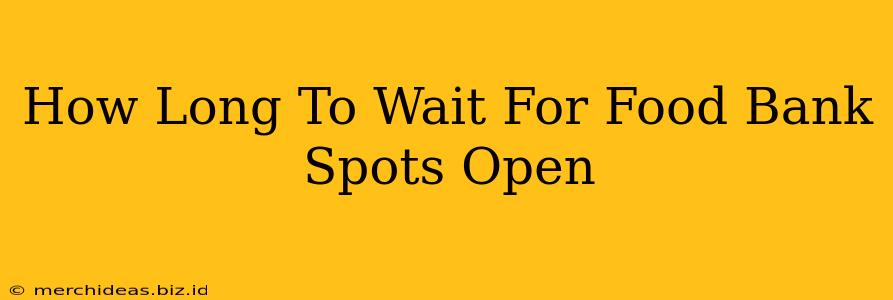Finding yourself needing assistance from a food bank can be a stressful experience. One of the first questions that often arises is: how long will I have to wait? The answer, unfortunately, isn't straightforward. Waiting times for food bank appointments or open spots vary significantly depending on several factors. This guide will explore these factors and provide you with valuable information to help you navigate this process more effectively.
Factors Affecting Food Bank Wait Times
Several key factors influence how long you might wait for a food bank appointment or an available spot:
1. Location and Demand:
- High-Need Areas: Food banks in areas with high poverty rates or limited access to grocery stores often experience higher demand, leading to longer wait times. Urban centers, for example, may have longer wait lists than rural areas.
- Seasonal Fluctuations: Demand typically increases during holidays and times of economic hardship. Expect longer wait times during these periods.
- Specific Food Bank Capacity: Larger food banks with more resources and staff might have shorter wait times compared to smaller, community-based organizations.
2. Type of Assistance:
- Pre-Scheduled Appointments: Some food banks operate on a pre-scheduled appointment system. These appointments may be booked weeks or even months in advance depending on demand.
- First-Come, First-Served: Other food banks operate on a first-come, first-served basis. In these cases, your wait time depends on how many people arrive before you. You might encounter significant lines, particularly during peak hours.
- Specific Programs: Some food banks offer specialized programs for seniors, families with children, or individuals with disabilities. These programs may have their own separate waitlists and processes.
3. Your Individual Circumstances:
- Documentation Required: Some food banks may require specific documentation, such as proof of income or residency. Gathering these documents can add time to the process.
- Eligibility Requirements: Each food bank has its own eligibility requirements. If your situation doesn't fully meet these requirements, it may take additional time to resolve any discrepancies.
Strategies to Minimize Wait Times
While you can't control demand or the capacity of your local food bank, you can take steps to minimize your own wait time:
- Call Ahead: Contact your local food bank directly. Inquire about their current wait times, appointment scheduling process, required documentation, and eligibility criteria. This can save you time and frustration.
- Check Online Resources: Many food banks have websites or online portals that allow you to check availability, pre-register, or even schedule appointments.
- Be Prepared: Gather any necessary documentation beforehand, such as identification, proof of address, or income verification.
- Be Flexible with Timing: Consider visiting during off-peak hours or days to potentially reduce your wait time.
- Explore Alternative Resources: If one food bank has an extensive waitlist, explore other options in your area. Local churches, community centers, or charities may also provide food assistance.
What to Expect When You Arrive
Once you're at the food bank, be prepared to be patient and courteous. Remember, everyone there is likely facing similar challenges. Be respectful of the staff and other individuals waiting.
In short, there's no single answer to "how long to wait." Proactive steps, such as calling ahead and being prepared, are key to navigating this process more efficiently. Remember that food banks are vital community resources, and their staff strives to serve everyone in need as quickly and effectively as possible.
